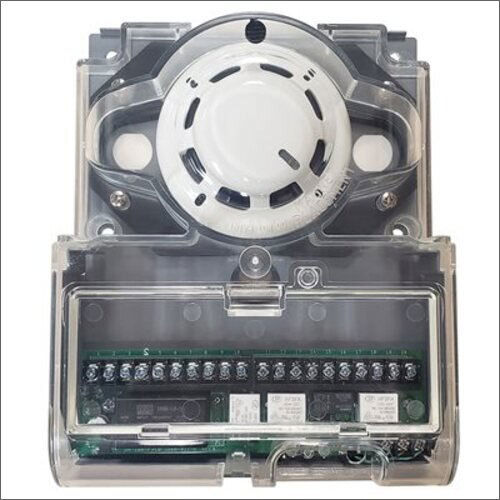Product Description
An addressable photoelectric duct detector is a specialized type of fire detection device used in commercial and industrial HVAC (Heating, Ventilation, and Air Conditioning) systems. These detectors are designed to detect smoke or other particles in the air within HVAC ductwork, which can be a critical part of fire safety and early warning systems in large buildings.
Here's a breakdown of what an addressable photoelectric duct detector is and how it works:
1. Photoelectric Detection: The "photoelectric" part of the name refers to the method of smoke detection. Photoelectric detectors work by using a light source and a sensor. A light beam is emitted into the detection chamber, and a sensor on the other side of the chamber detects the amount of light that reaches it. When smoke or other particles enter the chamber, they scatter the light, causing a reduction in the amount of light reaching the sensor. This change in light level triggers the detector to send an alarm signal.
2. Duct-Mounted: These detectors are specifically designed to be installed inside HVAC ducts. They are placed in the airflow path so that they can sample the air passing through the ductwork for the presence of smoke or particles.
3. Addressable: Addressable detectors are part of a larger fire alarm or building automation system. Each addressable device has a unique identifier (address), allowing the control panel to pinpoint the location of the activated detector. This is particularly useful in large buildings, as it allows for a quicker response during emergencies.
4. Integration: Addressable photoelectric duct detectors are integrated into the building's fire alarm system. When smoke or particles are detected, the detector sends a signal to the central control panel. The control panel can then activate alarms, notify building occupants, and alert the fire department if necessary.
5. Maintenance: Regular maintenance and testing are crucial for these detectors to ensure they remain operational. Dust and dirt buildup in ducts can affect their sensitivity, so periodic cleaning and inspection are necessary.
6. False Alarm Reduction: Photoelectric detectors are known for their reliability and lower susceptibility to false alarms compared to ionization detectors. They are better at distinguishing between actual smoke and common particles like dust or pollen.
7. Code Compliance: Addressable photoelectric duct detectors are typically installed in accordance with local fire safety codes and regulations. Building owners and facility managers must ensure compliance with these codes.
FAQ:
Q. What is an addressable photoelectric duct detector?
Ans: An addressable photoelectric duct detector is a specialized fire detection device designed to detect smoke or particles within HVAC ductwork. It is part of a larger fire alarm or building automation system.
Q. How does an addressable photoelectric duct detector work?
Ans: It employs photoelectric technology, using a light source and a sensor. When smoke or particles enter the detection chamber within the duct, they scatter the light, triggering the detector to send an alarm signal to a central control panel.
Q. Why are they used in HVAC systems?
Ans: Addressable photoelectric duct detectors are used to enhance fire safety in large buildings by detecting early signs of fire within HVAC ducts, where smoke and flames can quickly spread.
Q. What makes them "addressable"?
Ans: They are addressable because each detector has a unique identifier (address) within the system. This allows the control panel to identify the exact location of the activated detector, aiding emergency response.
Q. What is the advantage of photoelectric detection over other methods?
Ans: Photoelectric detection is known for its reliability and lower susceptibility to false alarms compared to ionization detection. It is better at distinguishing between actual smoke and common airborne particles.
Q. How often should addressable photoelectric duct detectors be inspected and maintained?
Ans: Regular maintenance and testing are essential. Depending on local regulations and manufacturer recommendations, this can range from monthly to annually. Dust and dirt accumulation can affect their sensitivity.
Q. What types of buildings typically use these detectors?
Ans: They are commonly found in commercial and industrial buildings, such as warehouses, factories, shopping centers, office complexes, hospitals, and high-rise buildings.
Q. Are there any regulations or codes governing the installation of these detectors?
Ans: Yes, installation should comply with local fire safety codes and regulations. Building owners and facility managers should ensure they are in compliance.
Q. Can addressable photoelectric duct detectors be integrated with other building systems?
Ans: Yes, they can often be integrated with HVAC controls, building management systems, and fire alarm systems for a comprehensive approach to building safety and automation.
Q. Do these detectors require any special training to install and maintain?
Ans: Proper installation and maintenance typically require training or certification from the manufacturer or an authorized service provider to ensure they function correctly and meet safety standards.
Q. What are some common troubleshooting steps if a duct detector is not functioning correctly?
Ans: Common troubleshooting steps include checking for obstructions, cleaning the detector, verifying power and communication connections, and consulting the user manual or manufacturer's guidelines.
Q. Can these detectors be part of a larger fire suppression system?
Ans: While they detect the presence of smoke or particles, they are not typically part of fire suppression systems. Fire suppression systems, such as sprinklers or gas-based systems, are designed to extinguish fires.
